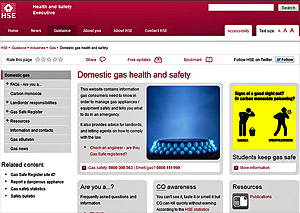Carbon Monoxide Awareness Crucial For Domestic Environment Safety
The image of a desperate person sitting in a car with a hose pipe through the window, the other end of which is attached to the exhaust pipe; and engine running, is probably the image that comes to mind whenever anyone mentions carbon monoxide poisoning.
But whilst this scenario has become a cliché in crime books, films, and TV series, the fact is that deaths and injuries from carbon monoxide poisoning, caused by bad fuel burning installations, and cowboy traders; is a problem making safety in the home something people should be taking seriously.
It is also an issue of course in work places that are not properly maintained and where gas or fossil fuels are burnt.
 In attempt to educate the public and offer advice to consumers, the HSE have launched Gas Safety in the domestic environment as an issue on their website.
In attempt to educate the public and offer advice to consumers, the HSE have launched Gas Safety in the domestic environment as an issue on their website.
Below is an excerpt:
Carbon monoxide (CO) is a colourless, odourless, tasteless, poisonous gas produced by incomplete burning of carbon-based fuels, including gas, oil, wood and coal. Carbon-based fuels are safe to use. It is only when the fuel does not burn properly that excess CO is produced, which is poisonous. When CO enters the body, it prevents the blood from bringing oxygen to cells, tissues, and organs.
You can't see it, taste it or smell it but CO can kill quickly without warning. According to the HSE statistics every year around 15 people die from CO poisoning caused by gas appliances and flues that have not been properly installed, maintained or that are poorly ventilated. Levels that do not kill can cause serious harm to health if breathed in over a long period. In extreme cases paralysis and brain damage can be caused as a result of prolonged exposure to CO. Increasing public understanding of the risks of CO poisoning and taking sensible precautions could dramatically reduce this risk.
There are signs that you can look out for which indicate incomplete combustion is occurring and may result in the production of CO;
- Yellow or orange rather than blue flames (except fuel effect fires or flueless appliances which display this colour flame)
- Soot or yellow/brown staining around or on appliances
- Pilot lights that frequently blow out
- Increased condensation inside windows
There are a number of simple steps that gas consumers can take to keep themselves safe.
Carbon Monoxide can be produced by any combustion appliance, including those that burn fossil fuels e.g. oil, wood and coal. If you have one of these appliances you should make sure that it is serviced and maintained by a competent person and the chimney is regularly swept.
The website pages continue with advice on symptoms of carbon monoxide poisoning, and what you should do if you suspect an appliance is producing carbon monoxide gas?
You can access the HSE Carbon Monoxide web pages here
Source: HSE


